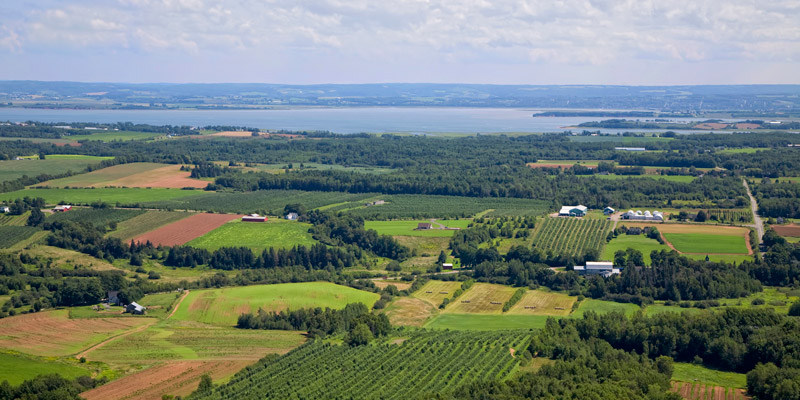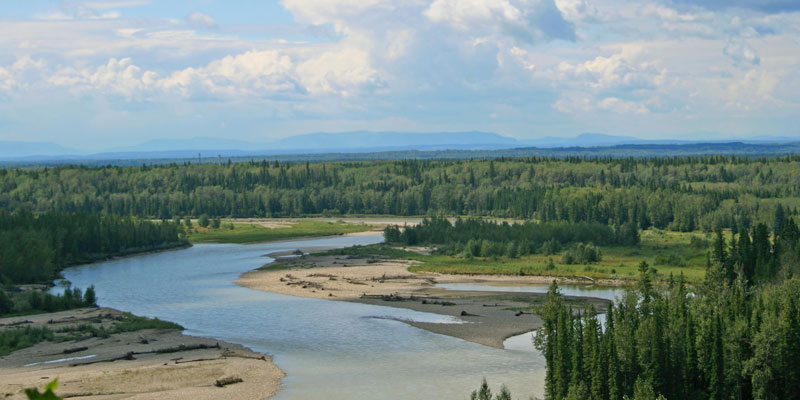Small-Scale Wastewater Management Initiative
Principal Investigator - Graham Gagnon, Professor, Dalhousie University (2001-2004)

Challenge
The primary sources of wastewater generated in rural Canada are from agricultural operations and small communities. Because of their size, conventional systems are not suitable and low cost natural treatment systems (eg. constructed treatment wetlands) are an attractive option. Constructed wetlands require no energy inputs, are easily managed, and are relatively inexpensive. The cold climate conditions experienced in Canada present a unique challenge to the successful implementation of these treatment systems. Accurate design methodologies, possible loading rates, winter management strategies and performance efficiencies must be determined to understand the complex chemical, biological and hydrological processes which control the ability of these systems to successfully treat wastewater.
This purpose of this research project was to define the treatment characteristics of low-cost wastewater treatment systems for rural wastewater through a series of innovative field and laboratory scale experiments. The central research goal was to develop a fundamental understanding, through controlled experimentation and biofilm modeling, of recirculating biofilters (RBFs) to develop a more robust design approach for the sustainable implementation of on-site biological systems. The key beneficiaries of this research are both agricultural producers and rural municipalities to better achieve affordable, effective waste water treatment.
Project
Small scale wastewater treatment systems must remove organics, nitrogen, phosphorus, and pathogens to meet the Canadian guidelines for disposal in surface water. This research project characterized factors which affected the performance of constructed wetlands in northern climates, and developed cost effective pre and post-treatment strategies to improve nutrient removal.
One research study modeled and evaluated recirculating biofilters (RBFs) to treat wastewater. The preliminary results showed that RBFs can achieve high level treatment for domestic wastewater, and that crushed glass can perform similarly to sand to serve as the medium for RBFs based on both bench-scale and field-scale studies. This research also determined the ability of peat filters to treat wastewater from both agricultural and domestic sources with varying levels of pre-treatment.
Researchers evaluated the effectiveness of alum sludge for removal of phosphorus for small scale wastewater treatment. Batch tests showed that alum sludge was effective in removing phosphorus (>90%) from these systems. Experimental results also indicated that effluent pH, aluminum and organic content leaching met the Canadian guideline for disposal in surface water in bench-scale experiments. Finally, studies examined small scale surface flow wetlands and the effects of artificial aeration and cold climates on treatment processes and removal efficiencies. When comparing actual retention times to theoretical retention times, they found that ideal flow conditions did not occur, and that artificial aeration improved removal efficiencies for several wastewater parameters.
Results from these studies supported evidence-based recommendations for producers on wastewater treatment through constructed wetlands and for the management of silage effluent.
Outputs
- Creation of a new venue for collaboration with Nova Scotia producers, including work with Nova Scotia Environmental Farm Plan Program and the Atlantic Swine Research Partnership, facilitating technology transfer activities.
- Development of farm-level information resources including factsheets on wastewater management using wetlands (e.g., Wetlands for the Treatment of Agricultural Wastewater in Nova Scotia), vegetative filters (e.g., Vegetated Infiltration Areas for the Management of Milkhouse Wastewater) and water disinfection (e.g., What You Should Know About Irrigation Water Quality Safety).
- Along with the above knowledge transfer activities, findings were disseminated through conference proceedings and academic journals.
- The research team produced a new granular media which was effective for Phosphorus removal, with the potential for patent development.
Select Presentations
Fahie, C.R., R.J. Gordon and G.A. Gagnon. 2002. Coupling peat filtration with granular adsorbents for treating agricultural wastewater. 2002 Joint CSCE/ASCE Environmental Engineering Conference. Niagara Falls, ON.
Mortula, M. and G.A. Gagnon. 2002. A review of physical-chemical approaches to phosphorus removal. Proceedings, International Conference on Bangladesh Environment (ICBEN – 2002). Dhaka, Bangladesh.
Smith, E., R. Gordon, A. Madani and G. Stratton. January 18, 2002. Phytoremediation techniques at the NSAC. Recent Developments in Phytoremediation Workshop for the National Research Council Canada. Halifax, Nova Scotia. (Presentation and abstract).2005 ASAE Annual International Meeting in Tampa Florida.
Select Publications
Hu, Z., M. Mortula, R.J. Gordon, and G.A. Gagnon. 2003. Agricultural wastes. Water Environ. Research. In press.
Jamieson, T.S., G. W. Stratton, R. Gordon, and A. Madani. 2003. The use of aeration to enhance ammonia nitrogen removal in constructed wetlands. Canadian Biosystems Engineering. 43: 1.9-1.14.
Jamieson, T.S., G. W. Stratton, R. Gordon, and A. Madani. 2002. Phosphorus adsorption characteristics of a constructed wetland soil receiving dairy farm wastewater. Can. J. Soil Sci 82: 97–104.
Jamieson, R., R. Gordon, G. Stratton, A. Madani and K. Sharples. 2002. Movement and persistence of fecal bacteria in agricultural soils and subsurface drainage water: A review. Canadian Biosystems Engineering 44:1.1-1.9.
Maertens, M.R., T.S. Dykstra, L. Truelstrup-Hansen and G.A. Gagnon. 2003. Inactivation of MS 2 and E. coli in the presence of colloidal and humic material. Proceedings, 2003 Annual CSCE Conference. Moncton, NB.
Mortula, M. and G.A. Gagnon. 2003. Phosphorus removal from aquaculture process water. Proceedings, 2003 Annual Canadian Society for Civil Engineering (CSCE) Conference. Moncton, NB.
Mortula, M., P.G. Wells, M.R. Islam, and G.A. Gagnon. 2003. Aluminum toxicity in fish from alum sludge: an ecological risk assessment. Proceedings, 2003 Annual CSCE Conference. Moncton, NB.
Smith, E., C. Fahie, R.J. Gordon, and G.A. Gagnon. 2002. Agricultural wastes. Water Environ. Research. 73(5): 1-24. (CD-ROM)
Smith, E., R. Gordon, A. Madani and G. Stratton. November 6-8, 2002. Winter management of constructed wetland treatment systems. In: Drinking Water Supplies Assessment and Management Strategies for the 21st Century. Virginia Water Research Symposium. Richmond, Virginia. VWRRC Special Report SR21-2002.
Trias, M., Z. Hu, M. Mortula, R.J. Gordon and G.A.Gagnon. 2003. Impact of seasonal variation on treatment of swine wastewater Canadian Biosystems Engineering. Under review.
Outcomes
- Changes in practice related to “low-cost” technology, with opportunities to enhance productivity in the agricultural sector, particularly for passive technologies such as wetlands and peat filters. The research outcomes can be incorporated into current wetland design methodologies for small scale wastewater management systems.
- To enhance the commercialization potential of the project, researchers worked closely with Nova Universities Technology (NU-Tech) office. The research team subsequently formed a collaborative relationship with epidemiologists to expand the project to examine the effects of water quality on health determinants, with a focus on water impacted by agricultural activities.
- The general concept of the design criteria and performance analysis of recirculating biofilters has been applied to seafood wastewater treatment, a new field of study. A further study was initiated to use RBFs to remove organic matter and some nutrients from the seafood processing wastewater.




